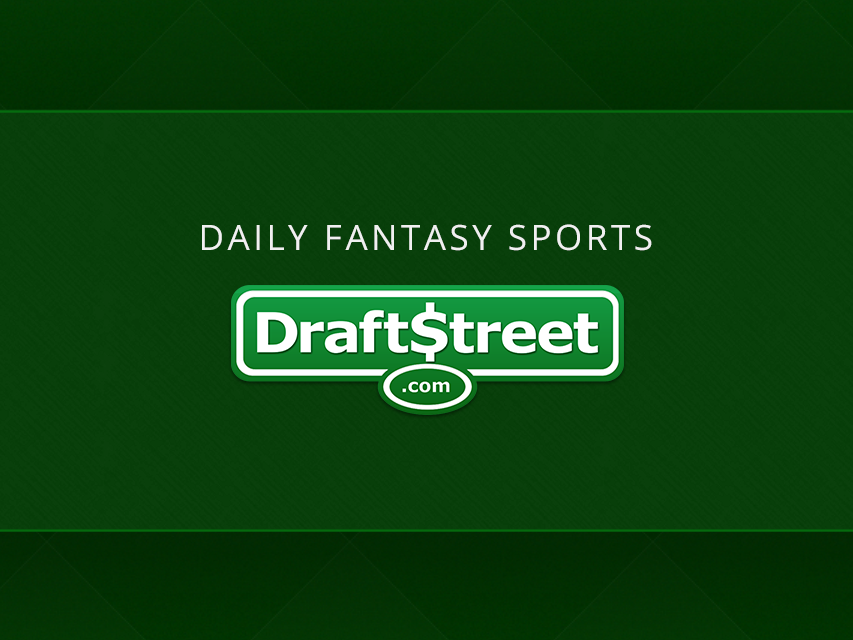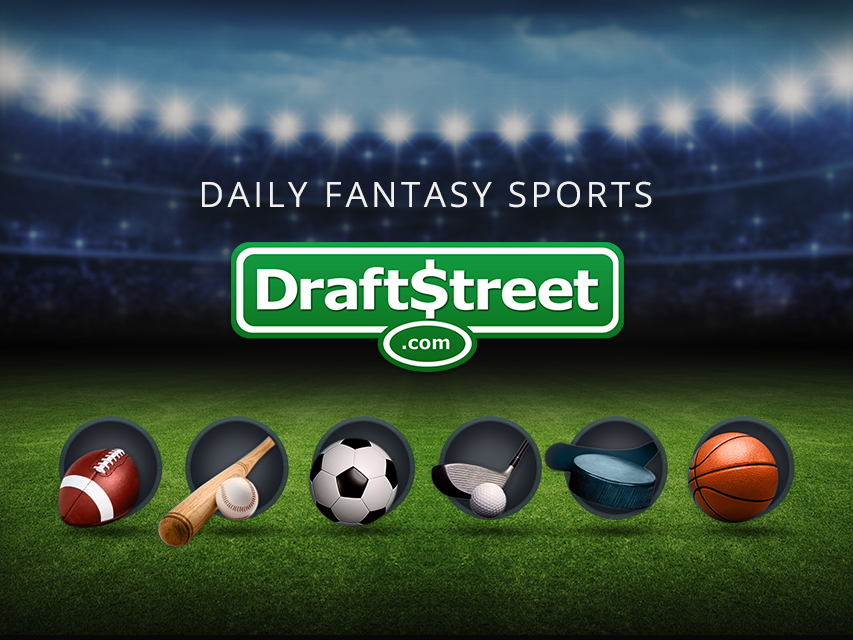EVgo is one of North America's Largest Public Electric Vehicle (EV) Fast Charging Networks powered by 100% renewable energy.
EVgo Access: Smart Parking App Feature
EVgo has developed an app feature that allows customers to access smart parking facilities and use EVgo chargers by scanning a QR code.
EVgo Access Report
In addition to this app feature, they created an internal complementary dashboard table to record these interactions called EVgo Access Report.
I led the design and managed a team of engineers in weekly sprints for three months to create a dashboard tool used in day-to-day operations that directly impacted customers using EVgo Access.
Most Significant Problems
A few months after the EVgo Access launch, the administrative team identified several issues that required immediate attention as they impacted the company’s financial performance.
» Customers were overstaying in paid facilities, accumulating thousands of dollars in parking fees that EVgo had to cover
» The overstayed customers still had active sessions and were blocking new customers from entering the gated facilities
» Evgo Admins had limited control and could not investigate customers’ sessions using the current setup
Considering the recent pain points from launching the new software, the EVgo team needed more oversight and control over how their customers used the gated facilities.
Presenting
EVgo Access Report 2.0
EVgo Access Report 2.0 Dashboard
Team & Timeframe
• 1 Product Owner
• 1 Product Designer & Manager (me)
• 2 Engineers
• Three-month delivery date
My Responsibilities
• Product Management
• Product Design
Working closely with the senior director of software and the head of customer operations, we decided to repurpose the existing report table and turn it into an internal tool that can be used as part of an admin’s operator panel to control settings and assist customers using EVgo Access.
Primary Objective
Create a dashboard tool allowing Admins to gain insights into EVgo Access charging sessions and the ability to close parking sessions, set courtesy times/rates, and charge users who overstay their welcome.
Project Scope
• View and Filter parking and charging session data
• Set courtesy time and rates
• Close parking session
• Charge violation fees
• User Authentication
• Export CSV files
Out of Scope
• Merge with EVgo Operator Portal
• In-app timer and alert for courtesy time expiration
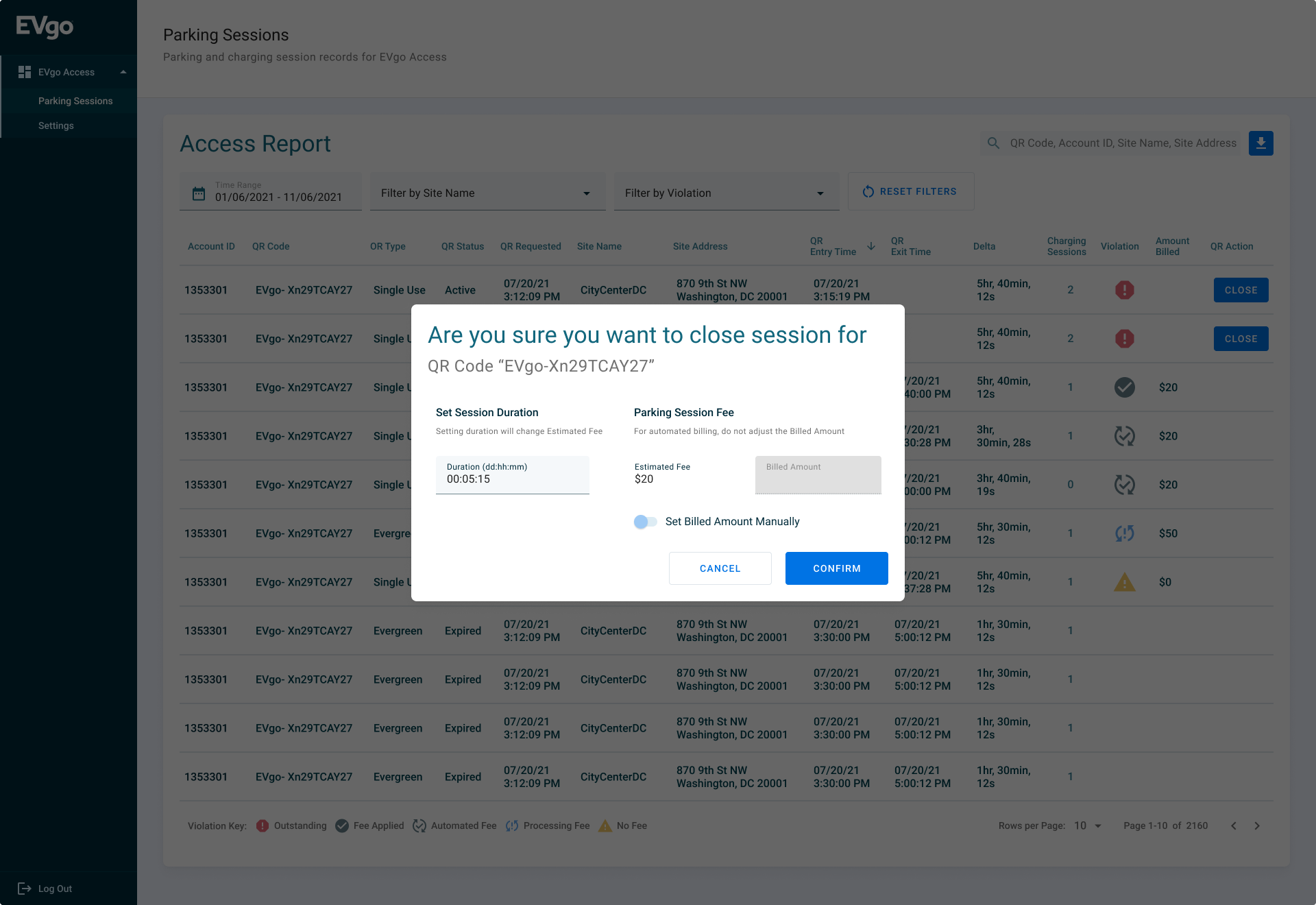
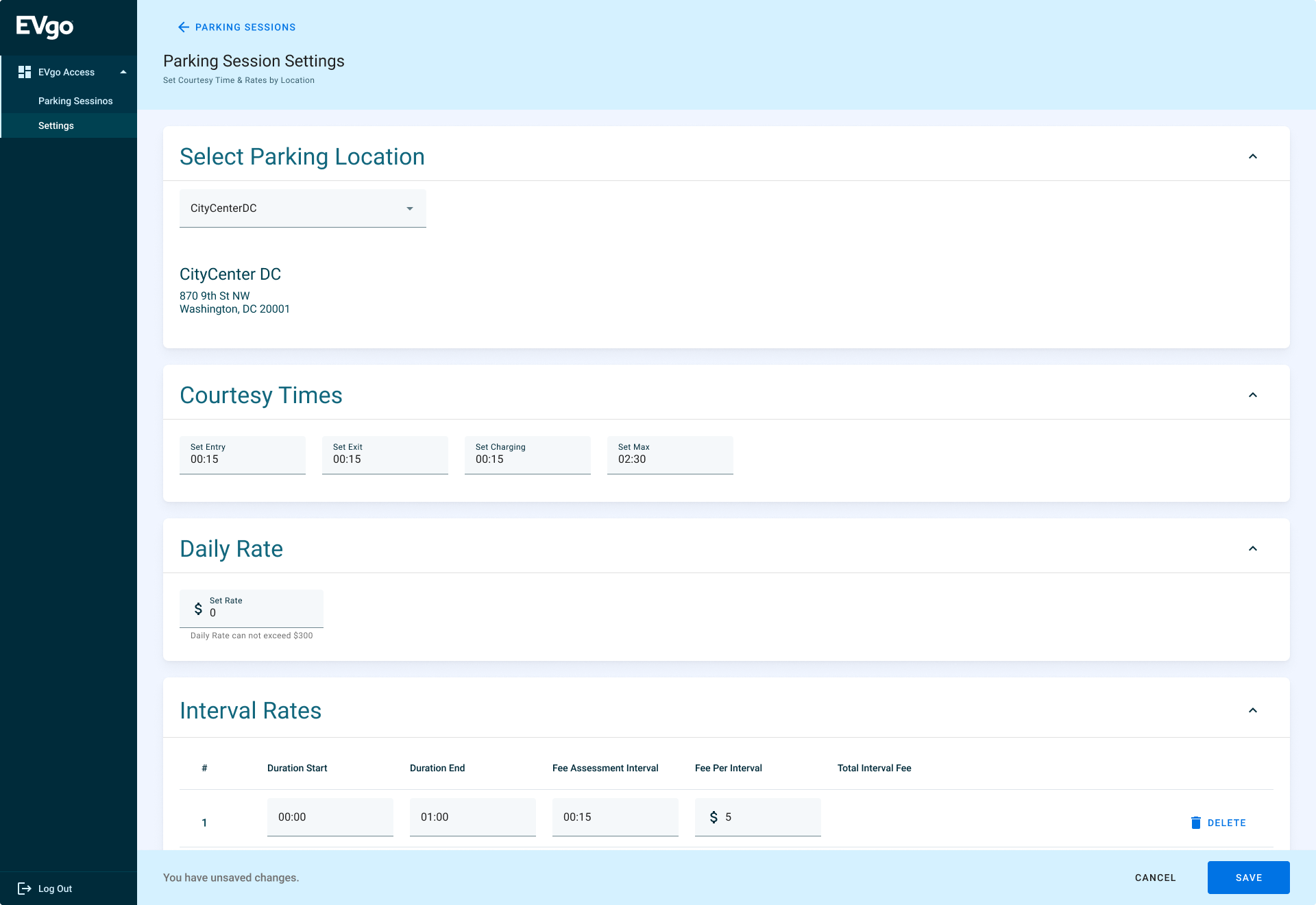
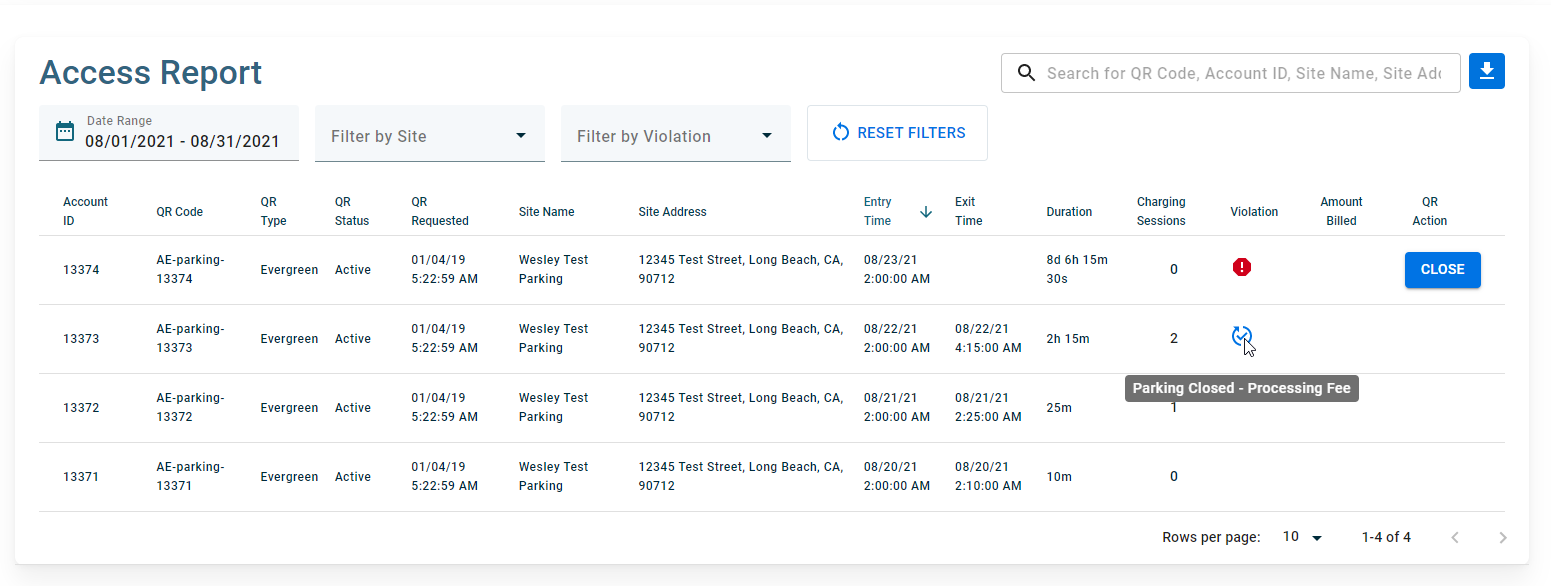

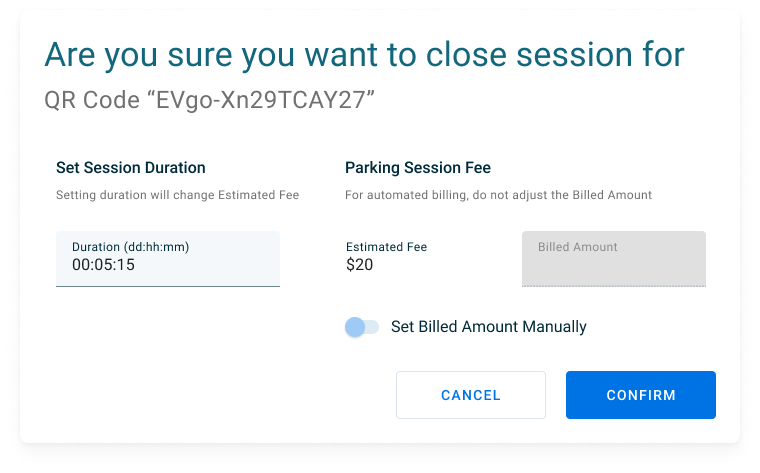


EVgo Access Report 2.0 screens and components
Challenges
With such a tight turnaround time and no formal BRD, working on this project presented my team with numerous challenges.
• The team needed to gather and define requirements on the fly
• Learn how EVgo Access operates from a user and technical perspective
• Comprehend existing data points and define new endpoints to function optimally
• Design and Dev started on the same day with no design system or handoff protocol
• Understand the admin experience and how it will impact the customer
Jira backlog and scrum workflow
Process
As the Product Designer and Manager(PDM), I implemented a proactive approach to project management by collaborating closely with two dedicated engineers and overseeing regular scrum methodologies for development. This process involved leading daily standup meetings, facilitating weekly sprint planning sessions, organizing demos, and conducting retrospectives. Following our team demo every Friday, I disseminated weekly notes, relevant links, and recordings to the entire marketing and communications teams to ensure comprehensive communication of production updates.
» Facilitated weekly scrum meetings involving Design Story Writing (DSW), sprint planning, demos, and retrospectives
» Established the Web Product Team’s channel to facilitate transparent communication of project updates
» Managed the scheduling of design, development, and stakeholder meetings
» Received project requirements from the Product Owner (PO) and provided support in defining acceptance criteria
» Initiated design sprints to align with feature development timelines
» Conducted design reviews during the weekly DSW meetings with the PO and engineers
» Developed prototypes of user flows for weekly demonstration purposes
» Oversaw the design to development workflow and managed the backlog
» Held regular one-on-one meetings with team members to provide support and gather feedbackResearch & Discovery
The team’s first DSW lasted over an hour, where we discussed dependencies, endpoints, and design. We reviewed the current report table and EVgo's Operator Portal (Admin Dashboard) and documented high-level requirements. We also set up a workflow on Jira so the engineers could begin tracking their work immediately. I led this meeting and several others over 12 weeks, during which the team defined more requirements and features delivered by our PO that I would translate into user stories and acceptance criteria for development.
Here are just a few highlights from what we uncovered.
Courtesy Time
One of the team's initial quests was how EVgo Access worked from a customer and technical perspective. We needed to understand the customers’ interactions between the smart garages and EVgo’s courtesy times.
During construction, logistical teams would estimate how much time a customer needed to enter a gated facility, find a charger, charge, and exit.
Courtesy Time Flowchart
Courtesy time was essential since it affected EVgo customers' direct actions, ensuring they stayed within their allotted time to charge in paid facilities. If a customer overstays their allotted time, this would cost EVgo an open charging station and potentially a garage fee for those in metropolitan areas.
Violation Types
After conducting the initial discovery of courtesy time, we determined what constituted a violation. We evaluated three types of violations that can occur when a customer uses EVgo Access.
Overstay exceeding max time: a customer stayed over the maximum allowed time.
Overstay with charging: a customer charged but stayed longer than the charging time plus the courtesy time.
Overstay without charging: a customer stayed more than the courtesy time and didn’t charge.
Daily and Interval Rates
Once we figured out courtesy times and violation types, the next step was investigating garage fees.
Using EVgo Access allows customers to enter paid facilities free from parking fees if they follow the procedures to enter, charge, and exit within the courtesy windows.
We found out that some facilities only have day rates, but many garages have different tiered fees for time of use.
UI/UX Design
While my engineering team concentrated on setting up the new back-end infrastructure and endpoints, I focused on the UI/UX design. Trying to stay a step ahead in our weekly sprints, I established a weekly design sprint and issued myself tickets that my team could follow along with and give feedback.
Learning EVgo used Material Design for their web apps alleviated some design decisions on my part, like which UI library we should use. After a few interview sessions with some of the engineers and customer operations admins, I gained insight into which components were already available in the Operator Portal and which patterns were familiar to the team -enabling me to align my designs with what was acceptable.
For example, one of the more complex features was setting rates on an interval. We ended up going with a similar design that EVgo admins already used for tariffs, which used multiple timer components to control start and end times and assess the rates.
User flows and Prototypes
During this project, I generated numerous screens and prototypes using Figma. After wrangling the components and diving into the styles, I created high-fidelity prototypes for stakeholders to review during our weekly demos. We also used them for testing to ensure we didn’t hit any dead ends and, most importantly, for dev handoff. They were indispensable in conveying design decisions to the dev team.
Prototype for closing a parking session
Solutions & Implementation
After three months of production, the EVgo Access Report has become the complementary tool for EVgo Access. It allows EVgo admins to monitor and assist customers using gated chargers, set courtesy times and rates, and hold customers accountable if they overstay their welcome.
Using what we learned from our research, DSWs, and conducting rigorous prototyping with stakeholders and the QA team, we implemented the following features to help give EVgo Admins more agency over EVgo Access.
Report Table
The following features allow admins to gain more accurate insights into customers using EVgo Access by enabling them to search, sort, and filter the report table.
• Search by QR code, account ID, site name, and address
• Sort parking and charging session data
• Filter by site name or by violation type
• Filter by selected date range
• Export CSV files
Close Parking Session
Now, EVgo can close parking sessions that have violated their courtesy times, saving them thousands of dollars in monthly parking fees.
In the Access Report table, each line item containing an open parking session is accompanied by a close button, allowing admins to end a customer’s session if they violate it.
There’s also a feature to adjust parking duration and “Set billed amount manually” for specific edge cases that customer operations admins might face when resolving customer issues.
Parking Session Settings
Understanding that multiple teams would use this product, we developed user authentication for user roles and permissions – Super Admin and Admin– allowing separation between the reporting tool and settings.
Super Admins have rights to the settings, while Admins can only view and operate the Access Report.
Super Admin abilities
• Select locations and view details
• Set courtesy times for selected locations
• Set daily rates or rates at intervals
• Plus, all capabilities as Admin users
Parking Session Settings
Set Courtesy Times
The following inputs were crucial for establishing various courtesy times for each location and determining violation type and billed amount.
Set Entry: Time received when users enter a garage to find a charger
Set Exit: Time received when users exit a garage
Set Charging: Time received each time a user charges, not including the first changing session (users can have multiple charges in a single session)
Set Max: The maximum allowed time to be in a parking location before being charged, regardless of courtesy totals
Violation Status
I chose icons to represent and visualize violation statuses to make it easier for admins to identify violation types when filtering and sorting the report table.
Outstanding: a session is still open and in violation of the rules
FeeApplied: an operator closed a session, and a fee was applied
Automated: a session has ended, and the system determined that there was a violation
ProcessingFee: a session was closed by an operator, and the fee has yet to be applied (fee assessed once the QR code scans)
NoFee: an operator closed a session with no fee charged
Setting Daily & Interval Rates
Rates and automated billing helped alleviate EVgo’s financial burden of parking fees by pushing the added costs onto the users. When setting courtesy times and rates, admins can enforce violations.
We developed a way to use intervals to set time to accommodate any price structure.
Duration Start: when this interval will start
Duration End: when this interval will stop
Fee Assessment Interval: the number of remaining minutes before charging a Fee Per Interval
Fee Per Interval: fee applied after each Fee Assessment Interval
Total Interval Fee: the total amount charged to a customer for the entire interval
Considerations & Insights
One Week of Onboarding, Two Companies
When I started working full-time for AE Studio, my first project was EVgo Access. My main challenge was getting up to speed quickly with two new teams. During my onboarding week at AE Studio, I shadowed another AE PDM as they wrapped up their work on another EVgo project. By my second week, we began our first sprint cycle on EVgo Access, and I went on to lead this project, as well as many others, over the next 20 months as a third-party contractor at EVgo.
Two Teams, Two Workspaces
During my tenure at EVgo, I concurrently operated under two distinct paradigms as a full-time employee of both AE Studio and EVgo. While my sense of belonging leaned more towards the EVgo team, one of my most notable accomplishments was expanding the AE team within EVgo. Initially, a team of four AE members, including myself, was dedicated to EVgo. However, within a year, this number grew to over 20, encompassing PMs, PDMs, TPMs, and developers. The experience was immensely rewarding and impactful.
Product Designer and Manager (PDM)
Initially, my team and I had limited knowledge about EVgo’s ecosystem as external contractors working for AE Studio. This lack of familiarity worked to our advantage for such a quick turnaround. However, serving as the PDM allowed me to learn more about how EVgo operated internally, as I needed to schedule stakeholder meetings, own the design process, and manage production. Ultimately, the project was successful because we were a small, agile team where design and development collaborated closely to solve problems. Through this approach, we implemented a new enterprise tool and cross-functioning process improvements that significantly impacted the organization.

